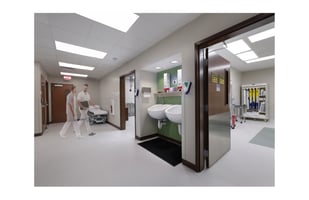Building an ambulatory healthcare facility requires careful planning, and one of the most critical...
The Most Overlooked Step in Opening an ASC
At the end of construction, before the client takes occupancy of a new ambulatory surgery center, one of the most crucial yet often overlooked steps is comprehensive training for the staff on the building’s systems.
In the rush to meet deadlines and open the doors, this necessary step is sometimes minimized or even skipped. When that happens, the users, often led by an administrator with a nursing rather than engineering background, are left unprepared to manage the facility’s complex systems. Unlike hospitals, ASCs rarely employ experienced facility engineers who can troubleshoot problems and maintain building systems. Without proper training, operations can quickly become reactive rather than proactive.
Complex Systems Require Informed Operators
ASC building systems are highly specialized. A lack of understanding about how they function or what they were designed to do can create frustration, downtime, and even compliance issues.
Some of the most important systems that require thorough post construction training include:
-
HVAC Systems: Heating, ventilation, and air conditioning systems serving the operating rooms, recovery areas, sterile storage, and central sterile must do more than simply provide comfort. They maintain strict temperature, humidity, pressurization, and air change requirements. Because of their complexity, it often takes time to get these systems commissioned and balanced so they work as intended. This can be frustrating when the focus is on opening the facility quickly. Training helps staff understand how the system operates, what parameters it was designed to maintain, and how to respond when problems arise. For example, if rooms feel warm on certain days, lowering the temperature setpoint may seem like an easy fix, but in reality it could create new problems, such as driving up the relative humidity. Staff should also know that seasonal changes often require system adjustments and that these adjustments are best performed by qualified technicians. Proper training helps staff recognize when to monitor and when to call for service. Even simple practices, like keeping doors and pass-through windows closed between rooms with pressure relationships, can make a big difference.


-
Emergency Power Systems: Generators and essential electrical systems must be regularly tested and maintained. Staff must understand how to test emergency lights, how to locate and read the generator annunciator panel, how to respond to faults, and to document testing appropriately. Surgical staff must be training in using line isolation monitors in the OR's.



-
Medical Gas Systems: Alarm panels for oxygen, medical air, and vacuum systems need to be understood. Staff should be trained to interpret alarms and know the procedures for resolving issues. The locations of zone valves to shut off gases in an emergency should also be reviewed.


-
Fire Alarm, Nurse Call, and Other Life-Safety Systems: Understanding how to interpret and respond to these alarms is essential for patient and staff safety.


Why This Training Matters
Staff often know the parameters they want in patient care spaces, for instance, that an operating room should be between 68-75 degrees, but they do not always understand the underlying system design or the steps needed to achieve and maintain those conditions. This gap creates a risk of improper system use and avoidable service calls.
Providing a clear understanding of the system’s design intent, operating ranges, and limitations can empower staff to identify when problems are operational versus when they require a contractor’s intervention.
Best Practices for End-of-Construction Training
-
Schedule and Coordinate Training Sessions Early. The general contractor should coordinate sessions with all relevant subcontractors and vendors before turnover.
-
Include the Right People. Administrators, charge nurses, and anyone responsible for day-to-day facility oversight should attend.
-
Capture Training on Video. Video recordings provide a valuable reference for onboarding new staff and refreshing knowledge.
-
Review Operation and Maintenance Manuals. These should be complete, clear, and reviewed with staff.
-
Plan for Ongoing Support. Establish a trusted relationship with a maintenance contractor who knows the systems and can provide seasonal adjustments and troubleshooting.
Investing Time Now Saves Frustration Later
The final weeks before opening a new ASC are a whirlwind of inspections, stocking supplies, and preparing staff for patient care. But skipping or rushing system training can undermine all that preparation.
Proper training creates confident operators, reduces downtime, minimizes unnecessary service calls, and ensures compliance with regulatory requirements. In short, it sets the stage for a smooth opening and a successful long-term operation.




